江苏省盐城市阜宁县明达初级中学七年级英语下册 7B Unit 4 Finding your way
- 格式:doc
- 大小:19.50 KB
- 文档页数:2
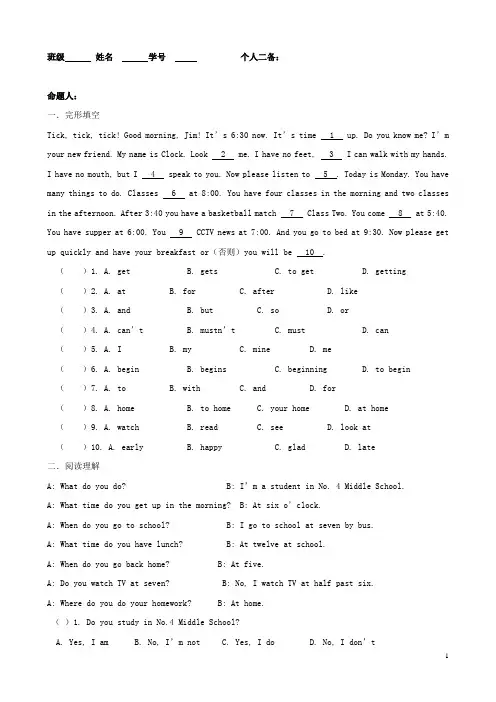
班级姓名学号个人二备:命题人:一.完形填空Tick, tick, tick! Good morning, Jim! It’s 6:30 now. It’s time 1 up. Do you know me? I’m your new friend. My name is Clock. Look 2 me. I have no feet, 3 I can walk with my hands.I have no mouth, but I 4 speak to you. Now please listen to 5 . Today is Monday. You have many things to do. Classes 6 at 8:00. You have four classes in the morning and two classes in the afternoon. After 3:40 you have a basketball match 7 Class Two. You come 8 at 5:40. You have supper at 6:00. You 9 CCTV news at 7:00. And you go to bed at 9:30. Now please get up quickly and have your breakfast or(否则)you will be 10 .()1. A. get B. gets C. to get D. getting()2. A. at B. for C. after D. like()3. A. and B. but C. so D. or()4. A. can’t B. mustn’t C. must D. can()5. A. I B. my C. mine D. me()6. A. begin B. begins C. beginning D. to begin()7. A. to B. with C. and D. for()8. A. home B. to home C. your home D. at home()9. A. watch B. read C. see D. look at()10. A. early B. happy C. glad D. late二.阅读理解A: What do you do? B: I’m a student in No. 4 Middle School.A: What time do you ge t up in the morning? B: At six o’clock.A: When do you go to school? B: I go to school at seven by bus.A: What time do you have lunch? B: At twelve at school.A: When do you go back home? B: At five.A: Do you watch TV at seven? B: No, I watch TV at half past six.A: Where do you do your homework? B: At home.()1. Do you study in No.4 Middle School?A. Yes, I amB. No, I’m notC. Yes, I doD. No, I don’t()2. How do you go to school every day?A. By bikeB. By busC. On footD. By car()3. Where do you have lunch?A. At schoolB. At homeC. At the restaurantD. At the dining room ()4. What time do you go home?A. At 4:00B. At 5:00C. At 6:00D. At 7:00()5. Where do you do your homework?A. At schoolB. At homeC. In the classroomD. In the library。
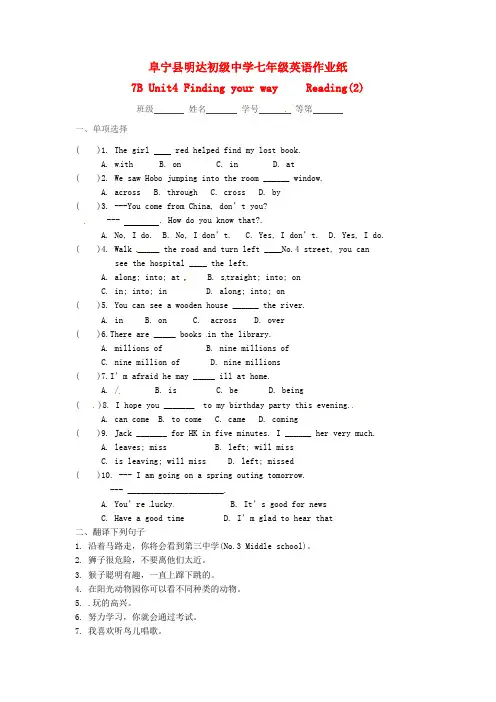
阜宁县明达初级中学七年级英语作业纸7B Unit4 Finding your way Reading(2)班级姓名学号等第一、单项选择( )1. The girl red helped find my lost book.A. w ithB. onC. inD. at( )2. We saw Hobo jumping into the room ______ window.A. acrossB. throughC. crossD. by( )3. ---You come from China, don’t you?--- . How do you know that?.A. No, I do.B. No, I don’t.C. Yes, I don’t.D. Yes, I do. ( )4. Walk _____ the road and turn left ____No.4 street, you can see the hospital ____ the left.A. along; into; atB. s traight; into; onC. in; into; inD. along; into; on( )5. You can see a wooden house ______ the river.A. inB. onC. acrossD. over( )6.There are _____ books in the library.A. millions ofB. nine millions ofC. nine million ofD. nine millions( )7.I’m afraid he may _____ ill at home.A. /B. isC. beD. being( )8. I hope you _______ to my birthday party this evening.A. can comeB. to comeC. cameD. coming( )9. Jack _______ for HK in five minutes. I ______ her very much.A. leaves; missB. left; will missC. is leaving; will missD. left; missed( )10. --- I am going on a spring outing tomorrow.--- ______________________.A. You’re luckyB. It’s good for newsC. Have a good timeD. I’m glad to hear that二、翻译下列句子1. 沿着马路走,你将会看到第三中学(No.3 Middle school)。
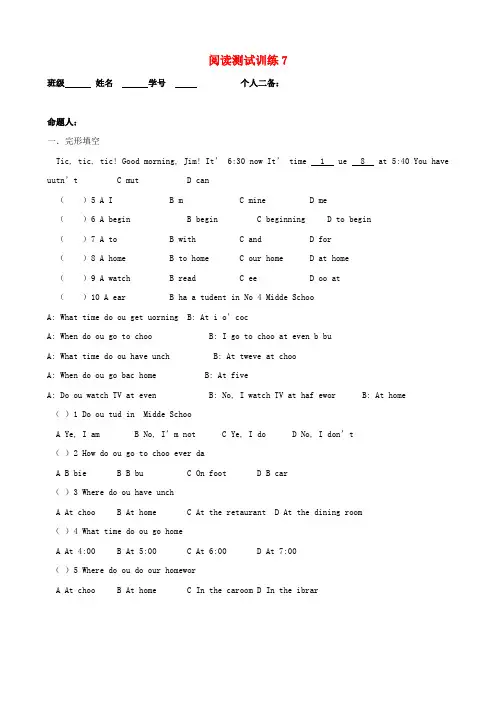
阅读测试训练7班级姓名学号个人二备:命题人:一.完形填空Tic, tic, tic! Good morning, Jim! It’ 6:30 now It’ time 1 ue 8 at 5:40 You have uutn’t C mut D can()5 A I B m C mine D me()6 A begin B begin C beginning D to begin()7 A to B with C and D for()8 A home B to home C our home D at home()9 A watch B read C ee D oo at()10 A ear B ha a tudent in No 4 Midde SchooA: What time do ou get uorning B: At i o’cocA: When do ou go to choo B: I go to choo at even b buA: What time do ou have unch B: At tweve at chooA: When do ou go bac home B: At fiveA: Do ou watch TV at even B: No, I watch TV at haf ewor B: At home()1 Do ou tud in Midde SchooA Ye, I amB No, I’m notC Ye, I doD No, I don’t()2 How do ou go to choo ever daA B bie B B bu C On foot D B car()3 Where do ou have unchA At chooB At homeC At the retaurantD At the dining room()4 What time do ou go homeA At 4:00B At 5:00C At 6:00D At 7:00()5 Where do ou do our homeworA At chooB At homeC In the caroomD In the ibrar。
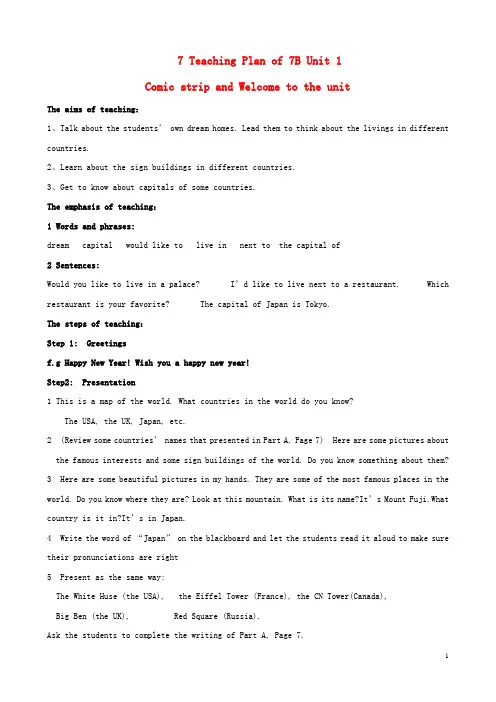
7 Teaching Plan of 7B Unit 1Comic strip and Welcome to the unitThe aims of teaching:1、Talk about the students’ own dream homes. Lead them to think about the livings in different countries.2、Learn about the sign buildings in different countries.3、Get to know about capitals of some countries.The emphasis of teaching:1 Words and phrases:dream capital would like to live in next to the capital of2 Sentences:Would you like to live in a palace? I’d like to live next to a restaurant. Which restaurant is your favorite? The capital of Japan is Tokyo.The steps of teaching:Step 1: Greetingsf.g Happy New Year! Wish you a happy new year!Step2: Presentation1This is a map of the world. What countries in the world do you know?The USA, the UK, Japan, etc.2(Review some countries’ names that presented in Part A, Page 7) Here are some pictures about the famous interests and some sign buildings of the world. Do you know something about them? 3Here are some beautiful pictures in my hands. They are some of the most famous places in the world. Do you know where they are? Look at this mountain. What is its name?It’s Mount Fuji.What country is it in?It’s in Japan.4Write the word of “Japan” on the blackboard and let the stude nts read it aloud to make sure their pronunciations are right5 Present as the same way:The White Huse (the USA), the Eiffel Tower (France), the CN Tower(Canada),Big Ben (the UK), Red Square (Russia).Ask the students to complete the writing of Part A, Page 7.Step 3 Presentation1 T:Here is a picture of Tiananmen Square. Do you know what country it is in?Ss:Yes. It’s in China.T:What city is it in?Ss:It’s in Beijing.T: As we all know, Beijing is the capital of China. (Write “capital” on the blackboard and ask the students read it aloud.)2 T:(Write these words on the blackboard) Do you know the capital cities of the countries in Part A? Look at the capital cities in the right column and match them with the correct countries.The USA TokyoThe UK OttawaFrance MoscowJapan Washington DCRussia LondonCanada Paris3(Ask one student to come to the blackboard to match them then check out)Make dialogues like this:-----What city is the capital of the USA?----- The capital of the USA is Washington DC.------ And what is the capital of France?------ The capital of the France is Paris.Step 4 Practice1 Get the students to read the conversation after the tape first.2 Practice in pairs.Step 5 Presentation1 Ask: What country would you like to live in?2 Look, there are two places here. One is a restaurant and the other is a palace. (Write “palace” on the blackboard and ask the students read it aloud)Then ask: Where would you like to live?.Where do you think Eddie would like to live?3 Play the tape of Comic strip for the students. Ask the students to find the answer.He would like to live next to a restaurant.4 Ask the students to read the dialogue aloud in the Comic strip and answer the questions : Why would Eddie like to live next to a restaurant?Which is Eddie’s favorite restaurant?Why does he like the biggest one? Can you guess?Step 6 Acting1Read the dialogue with your partner, then I will ask some groups to come to the blackboard to act it out. (Encourage them)2 Practice in pairs.Step 9 Homework1 Learn the new vocabulary and the dialogues by heart.2 Write something about your own dream homes.。
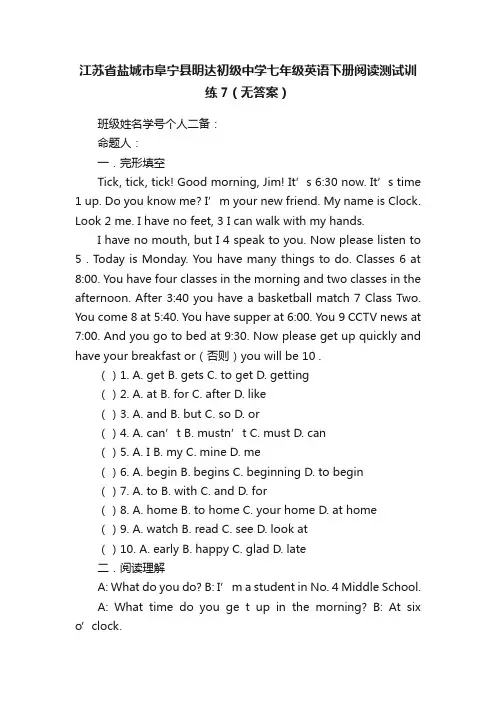
江苏省盐城市阜宁县明达初级中学七年级英语下册阅读测试训练7(无答案)班级姓名学号个人二备:命题人:一.完形填空Tick, tick, tick! Good morning, Jim! It’s 6:30 now. It’s time 1 up. Do you know me? I’m your new friend. My name is Clock. Look 2 me. I have no feet, 3 I can walk with my hands.I have no mouth, but I 4 speak to you. Now please listen to5 . Today is Monday. You have many things to do. Classes6 at 8:00. You have four classes in the morning and two classes in the afternoon. After 3:40 you have a basketball match7 Class Two. You come8 at 5:40. You have supper at 6:00. You9 CCTV news at 7:00. And you go to bed at 9:30. Now please get up quickly and have your breakfast or(否则)you will be 10 .()1. A. get B. gets C. to get D. getting()2. A. at B. for C. after D. like()3. A. and B. but C. so D. or()4. A. can’t B. mustn’t C. must D. can()5. A. I B. my C. mine D. me()6. A. begin B. begins C. beginning D. to begin()7. A. to B. with C. and D. for()8. A. home B. to home C. your home D. at home()9. A. watch B. read C. see D. look at()10. A. early B. happy C. glad D. late二.阅读理解A: What do you do? B: I’m a student in No. 4 Middle School.A: What time do you ge t up in the morning? B: At six o’clock.A: When do you go to school? B: I go to school at seven by bus.A: What time do you have lunch? B: At twelve at school.A: When do you go back home? B: At five.A: Do you watch TV at seven? B: No, I watch TV at half past six.A: Where do you do your homework? B: At home.()1. Do you study in No.4 Middle School?A. Yes, I amB. No, I’m notC. Yes, I doD. No, I don’t()2. How do you go to school every day?A. By bikeB. By busC. On footD. By car()3. Where do you have lunch?A. At schoolB. At homeC. At the restaurantD. At the dining room ()4. What time do you go home?A. At 4:00B. At 5:00C. At 6:00D. At 7:00()5. Where do you do your homework?A. At schoolB. At homeC. In the classroomD. In the library。
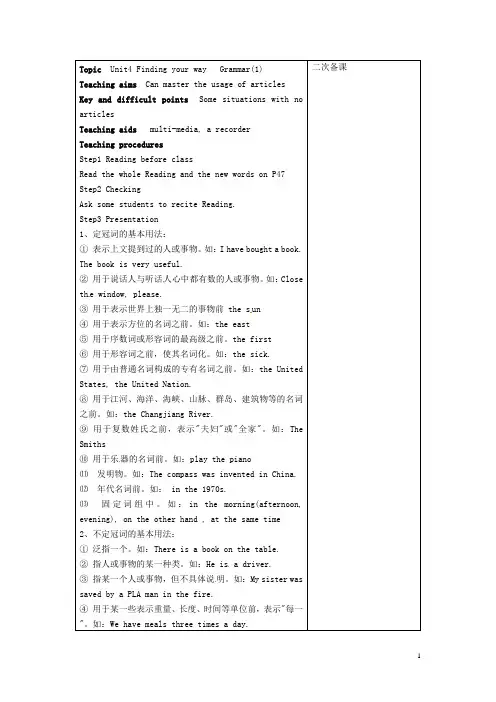
二次备课Topic Unit4 Finding your way Grammar(1)Teaching aims Can master the usage of articlesKey and difficult points Some situations with noarticlesTeaching aids multi-media, a recorderTeaching proceduresStep1 Reading before classRead the whole Reading and the new words on P47Step2 CheckingAsk some students to recite Reading.Step3 Presentation1、定冠词的基本用法:① 表示上文提到过的人或事物。
如:I have bought a book.The book is very useful.② 用于说话人与听话人心中都有数的人或事物。
如:Closeth e window, please.③ 用于表示世界上独一无二的事物前 the s un④ 用于表示方位的名词之前。
如:the east⑤ 用于序数词或形容词的最高级之前。
the first⑥ 用于形容词之前,使其名词化。
如:the sick.⑦ 用于由普通名词构成的专有名词之前。
如:the UnitedStates, the United Nation.⑧ 用于江河、海洋、海峡、山脉、群岛、建筑物等的名词之前。
如:the Changjiang River.⑨ 用于复数姓氏之前,表示"夫妇"或"全家"。
如:TheSmiths⑩ 用于乐器的名词前。
如:play the piano⑾发明物。
如:The compass was invented in China.⑿年代名词前。
如: in the 1970s.⒀固定词组中。
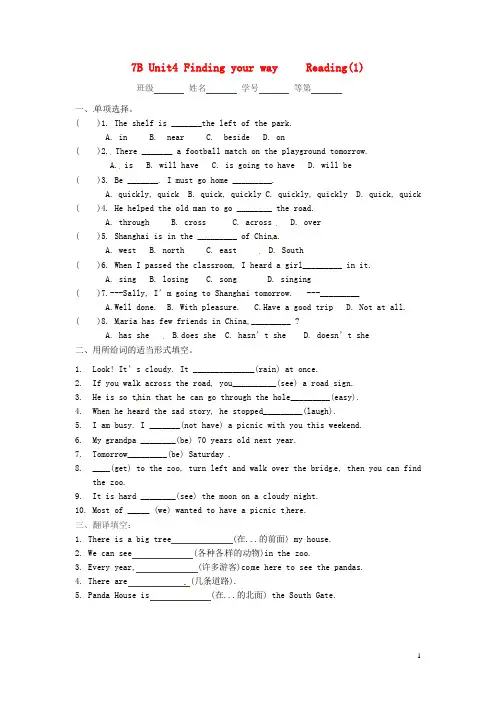
7B Unit4 Finding your way Reading(1)班级姓名学号等第一、单项选择。
( )1. The shelf is _______the left of the park.A. inB. nearC. besideD. on( )2. There _______ a football match on the playground tomorrow.A. isB. will haveC. is going to haveD. will be( )3. Be _______. I must go home _________.A. quickly, quickB. quick, quicklyC. quickly, quicklyD. quick, quick ( )4. He helped the old man to go ________ the road.A. throughB. crossC. acrossD. over( )5. Shanghai is in the _________ of Chin a.A. westB. northC. eastD. South( )6. When I passed the classroom, I heard a girl_________ in it.A. singB. losingC. songD. singing( )7.---Sally, I’m going to Shanghai tomorrow. ---_________A.Well done.B. With pleasure.C.Have a good tripD. Not at all. ( )8. M aria has few friends in China,_________ ?A. has sheB.does sheC. hasn’t sheD. doesn’t she二、用所给词的适当形式填空。
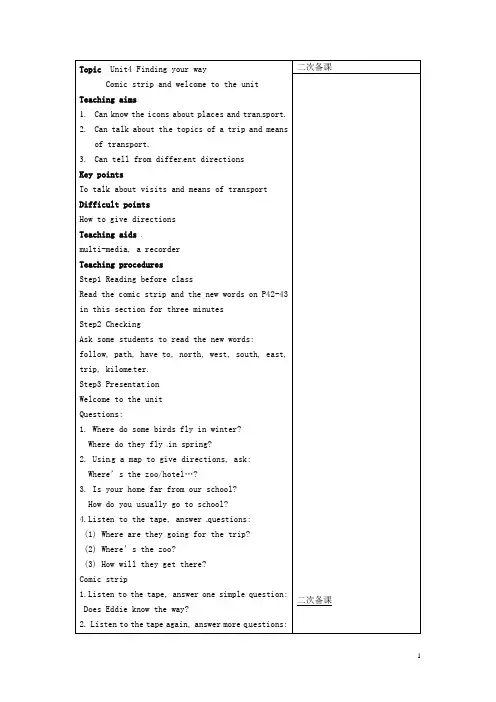
Topic Unit4 Finding your wayComic strip and welcome to the unitTeaching aims1. Can know the icons about places and tran sport.2. Can talk about th e topics of a trip and means of transport.3. Can tell from differ ent directionsKey pointsTo talk about visits and means of transportDifficult pointsHow to give directions Teaching aids multi-media, a recorder Teaching proceduresStep1 Reading before classRead the comic strip and the new words on P42-43in this section for three minutesStep2 Checking Ask some students to read the new words: follow, path, have to, north, west, south, east, trip, kilome ter.Step3 Presentat ionWelcome to the unitQuestions: 1. Where do some birds fly in winter? Where do they fly in spring? 2. Usin g a map to give directions, ask:W here’s the zoo/hotel …?3. Is your home far from our school?How do you usually go to school?4.Listen to the tape, answer questions: (1) Where are they going for the trip? (2) W here’s the zoo?(3) How will they get there?Comic strip1.Listen to the tape, answer one simple question:Does Eddie know the way? 2. Listen to the tape again, answer more q uestions: 二次备课二次备课(1) Where are Hobo and Eddie?(2) Can Eddie go down the hill?(3) What does the sign say?Step4 Exercises in class1、写出方位词东南西北东南西南东北西北2、翻译:(1)下去(2)不得不,必须(3)远离(4)上去(5)跟着我(6)去参加班级旅行(7)别这么肯定,我们请老师帮忙吧。
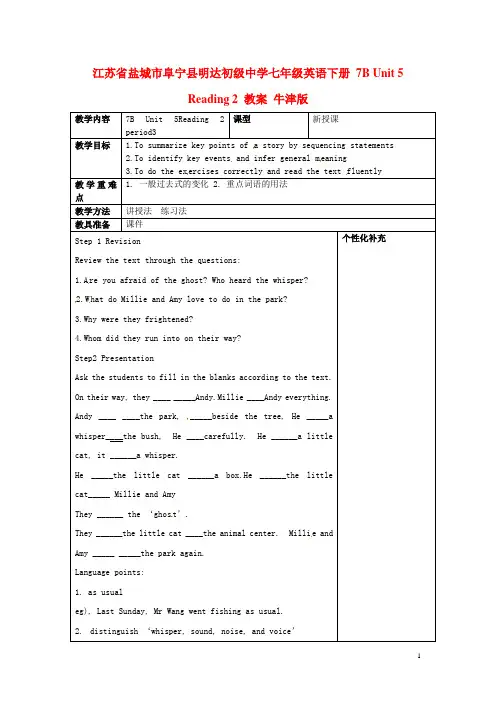
江苏省盐城市阜宁县明达初级中学七年级英语下册7B Unit 5Reading 2 教案牛津版课型新授课教学内容7B Unit 5Reading 2period3教学目标 1.To summarize key points of a story by sequencing statements2.To identify key events and infer general m eaning3.To do the ex ercises correctly and read the text fluently1. 一般过去式的变化2. 重点词语的用法教学重难点教学方法讲授法练习法教具准备课件个性化补充Step 1 RevisionReview the text through the questions:1.A re you afraid of the ghost? Who heard the whisper?2.W hat do Millie and Amy love to do in the park?3.Why were they frightened?4.Whom did they run into on their way?Step2 PresentationAsk the students to fill in the blanks according to the text.On their way, they ____ _____lie ____Andy everything.Andy ____ ____the park, _____beside the tree, He _____awhisper____the bush, He ____carefully. He ______a littlecat, it ______a whisper.He _____the little cat ______a box.He ______the littlecat_____ Millie and AmyThey ______ the ‘ghos t’.They ______the little cat ____the animal center. Milli e andAmy _____ _____the park again.Language points:1. as usualeg), Last Sunday, Mr Wang went fishing as usual.2.distinguish ‘whisper, sound, noise, and voice’whisper v.&n.eg) Xiao Wang whispered something in Xiao Ming’s ear. Mary spoke in a whisper.sound n.&v. Eg) Can you hear the sound of the piano? It sounds great.noise n. Eg) Don’t make any noises in the classroom. voice n. Eg) Ms Wu has a sweet and soft voice.3 on one’s way to a placeon their way to place4. say to oneself5. take care of =look after6. not ….any more =not ……any longer= no longereg) I am not afraid of tigers any more.=I am not afraid of tigers any longer.=I am no longer afraid of tigers.Step 3 PracticeTranslation:a. 他像往常一样去上学。

江苏省盐城市阜宁县明达初级中学七年级英语下册7B Unit 4 Finding your way Grammar (2)教案牛津版Grammar(2)Teaching aims1.能运用方位介词来表达物体的位置。
2.掌握本课时的所有生词和句型。
Key points掌握一些方位介词的基本用法Difficult points一些方位介词之间的区别Teaching aidsmulti-media, a recorderTeaching proceduresStep1 Reading before classRead the new words on P47-48Step2 CheckingAsk some students to read the new words on P47-48Step3 PresentationQuestions:1. Ho w can we understand the relationship of “between…and…”, “in front of”and “behind”?2, How can we understand the relationship of insideand outsid e?3. How can we understand the relationship ofbeside, next to, right and left?4. How can we understand the differences betweenon, over and above?5. How can we understand the differences betweenbelow and under?Step4 Exercises in class翻译句子:1. 梅梅坐在我的前面,我坐在她的后面。
2. 她正在学校门口等着妈妈。
3. 迈克坐在吉姆和萨姆之间。
4. 医院对面有一家银行。
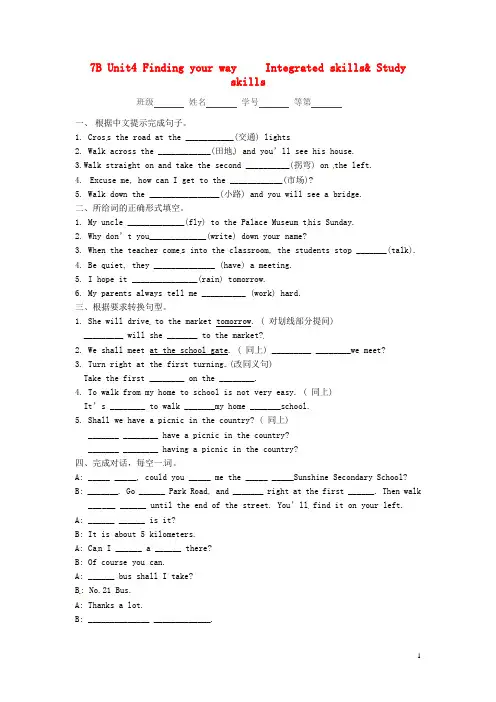
7B Unit4 Finding your way Integrated skills& Studyskills班级姓名学号等第一、根据中文提示完成句子。
1. Cros s the road at the ___________(交通) lights2. Walk across the ____________(田地) and you’ll see his house.3.Walk straight on and take the second __________(拐弯) on the left.4.Excuse me, how can I get to the ____________(市场)?5. Walk down the ________________(小路) and you will see a bridge.二、所给词的正确形式填空。
1. My uncle _____________(fly) to the Palace Museum t his Sunday.2. Why don’t you_____________(write) down your name?3. When the teacher come s into the classroom, the students stop _______(talk).4. Be quiet, they ______________ (have) a meeting.5. I hope it _______________(rain) tomorrow.6. My parents always tell me __________ (work) hard.三、根据要求转换句型。
1. She will drive to the market tomorrow. ( 对划线部分提问)_________ will she _______ to the market?2. We shall meet at the school gate. ( 同上) _________ ________we meet?3. Turn right at the first turning.(改同义句)Take the first ________ on the ________.4. To walk from my home to school is not very easy. ( 同上)It’s ________ to walk _______my home _______school.5. Shall we have a picnic in the country? ( 同上)_______ ________ have a picnic in the country?_______ ________ having a picnic in the country?四、完成对话,每空一词。
某某省某某市阜宁县明达初级中学七年级英语下册 7B Unit 7 Abilities Teaching Plan of教案牛津版主备人:Topic: Wele to the unit and ic stripTeaching aims:1.To introduce and expand vocabulary to describe dangerous situations.2.To guess context from the text title and the picture.3.To infer general meaning from picture and actions.4.To identify the name of specific places and actions.5.To skim the text for overall meaning and scan for detail.Main points and Difficult points:1. To learn the new words and some important phrases.2. To grasp the general idea of the text.Teaching aids:PPT and recorderTeaching Procedures:Step 1: Lead-in1. RevisionRevise what the students learned in the last period.1..be careful with2. visit a home for the elderly3.give a seat to someone on the bus4. plant trees5. collect things for Project Hope6.clean up the park/playground7.plant trees8.have the ability to do sth.9. How cool!2. Use these language points to describe what a member should do in the HelpingHands Club.(Work in groups. Have a discussion.)3. lead-inNext, we will learn a true story about helping others in danger.Before it, let’s learn some new words together.Step 2: New wordse some pictures and some examples to help the students to learn the new words.2. Finish B1 together with the students and check the answers.Keys: 1—e 2—a 3—b 4—c 5—f 6—dStep 3: Listen and answer1. Present some questions on PPT and ask them to read them.2. Listen to the tape and answer the questions.(Students can read after the tape lightly.)Step 4: Fast reading1. Read the text quickly and try to get some information. Then answer the T or Fquestions.1). Zhang Hua helped her classmate out of a fire.2). Zhang Hua’s neighbour is 79 years old.3). Mr. Sun couldn’t get out because he hurt his arm.4). Was Zhang Hua afraid when she saw a lot of smoke.5). Zhang Hua put out the fire with a blanket and helped Mrs. Sun out.6). The fire burned Zhang Hua’s neck and leg s.7). Zhang Hua was in hospital for two months.8). Zhang Hua said he was glad to help others and fire was not dangerous.2. Discuss in groups and present the answers by groups.Step 5: Further reading and practice1.Have an interview.2. Read and understand the dialogue.Step 6: Environmental education1. Fire safety.2. Environmental educationStep 7: Practice1. Finish the exercises on the handout in class.2. Check the answers in groups.(If there are some different answers from other groups, the students may havea discussion.)Step 8: Homework1. Recite some useful words and phrases.2. Finish the exercises on the handout.教后记:阜宁县明达初级中学七年级英语教案Teaching Plan of 7B Unit7主备人:Topic: Reading (1)Teaching aims:1. Learn the new and important phrases and sentence structures of Reading part.2. Get the students to learn how to describe an event.3. To identify names of specific places and actionsMain points and Difficult points:1. Master the new words and phrases2. Learn how to describe an event.Teaching aids:PPT and recorderTeaching Procedures:Step 1: Revision1. Review the new words of the Reading Part and have a dictation.1. ability2. dangerous3. fly4. careful5.carefully6. collect7.elderly8.brave9. alone 10. smoke 11. hurt 12. pour13. over 14. rush 15. save 16. put out17. blanket 18. burn 19. arm 20. fire2. Ask the students to read the text after the tape again.3. Ask the students ask and answer questions about the story.1) Did Zhang Hua go out on May 1oth?2) How old was Mrs. Sun?3) How did Zhang Hua put out the fire?4) How long was Zhang Hua in hospital?5) Did Zhang Hua think fire was very dangerous?4. Check the answers.Step 2: Lead-in1. Use these language points to describe what a member should do in the HelpingHands Club.(Work in groups. Have a discussion.)2. lead-inNext, we will learn a true story about helping others in danger.Before it, let’s learn some new words together.Step 3: Listen and answer1. Present some questions on PPT and ask them to read them.1). How old is the brave boy?2). How old is Mrs Sun?3). Where was Mrs Sun when there was a fire?4). Why couldn’t Mr s Sun get out of his house?5). How did zhang hua put out the fire?6). Did zhang hua hurt herself?7). How long was zhang hua in hospital?2. Listen to the tape and answer the questions.(Students can read after the tape lightly.)Step 4: Retell the storyOn 10th May, Zhang Hua …Suddenly, he heard…, then he found…Zhang Hua ran …, poured…, rushed …and put out ….He was burnt by the fire and ….He said, “…”.Homework1) Read the article after class and find out the difficult sentences.2) plete Part B (B1 & B2), Part C2.教后记:阜宁县明达初级中学七年级英语教案Teaching Plan of 7B Unit7主备人:Topic: Reading (2)Teaching aims:1.To introduce and expand vocabulary to describe dangerous situations.2.To guess context from the text title and the picture.3.To infer general meaning from picture and actions.4.To identify the name of specific places and actions.5.To skim the text for overall meaning and scan for detail.Main points and Difficult points:Master the new words and phrasesLearn how to use the words and phrases.Teaching aids:PPT and recorderTeaching Procedures:Step1.Reading before classAsk the students to read the dialogues.Step2: Fast reading1. Read the text quickly and try to get some information. Then answer the T or Fquestions.1). Zhang Hua helped her classmate out of a fire.2). Zhang Hua’s neighbour is 79 years old.3). Mr. Sun couldn’t get out because he hurt his arm.4). Was Zhang Hua afraid when she saw a lot of smoke.5). Zhang Hua put out the fire with a blanket and helped Mrs. Sun out.6). The fire burned Zhang Hua’s neck and legs.7). Zhang Hua was in hospital for two months.8). Zhang Hua said he was glad to help others and fire was not dangerous.2. Discuss in groups and present the answers by groups.Keys: F F F F T F T F(If the answer is F, give the correct answer.)Step 3: Further reading and practice1. Have an interview.First, fill in blanks on B2 together with the students.Then ask the students to read the conversation loudly.Next, ask the students to read the dialogue in pairs.Finally, ask several pairs of students to act out the dialogue. One is Zhang Hua. The other is Host.2. Read and understand the dialogue.1) Ask the students to read the dialogue by themselves. Try to find out the fivemistakes in it.2) Check the answer with the students.3) Read the dialogue loudly together. Present some language points.What happened to …? …发生什么事了?= What was wrong with …?He heard his neighbour calling for help.hear sb. doing sth. 听见某人正在做某事Step 4: Practice1. Finish the exercises on the handout in class.2. Check the answers in groups.(If there are some different answers from other groups, the students may havea discussion.)Step5.WritingGroup work. The students work in groups of four to make up sentences to talk about the topic.Homework1. Recite some useful words and phrases.2. Finish the exercises on the handout.教后记:。
江苏省盐城市阜宁县明达初级中学七年级英语下册 7B Unit 6 Outdoor fun Grammar教案牛津版Teaching aims and demands:1. Be able to use the simple past tense to make positive and negative sentences.2. Be able to use the simple past in dialogues.Teaching steps:Step 1.Revision1.Revise the simple past in last unit. Help the simple past tense ofte verbs below:start reply leave lovesay tell play meetstand plan hear bring2.Revise the ReadingDo you still remember Alice’s adventure? Let’s see how well you know about it. Please answer the questions.Who did Alice sit by a river with? (She sat with her sister.)What did she hear then? (She hear d a sound.)What did she see passing by? (She saw a rabbit passing by.)Did the rabbit run after Alice? (No, they weren’t.)Step 2.Presentation1.When they answer the questions, pay attention to correcting themistakes.2.Read the Page73 and discuss the positive and negative sentences.3.Finish the exercises:Alice sat by the river with her sister.(改为一般疑问句并作肯定和否定回答)The rabbit took a watch out of its pocket.(对划线部分提问)The rabbit ran after Alice.(改为否定句)Alice found a key on a small table.( 对划线部分提问)Alice put the key into a small door.( 对划线部分提问)Step 3 D rills1.Tell the Ss: Millie is writing about what she and her friends didlast weekend. Help her complete her article with correct forms of the verbs in the box.2.Show the pictures above Part A, and let the Ss discuss like this: S1: Did Millie go to the zoo last weekend?S2: No, she didn’t .S3: What did Millie do last weekend?S4: She went to the park.3.Show the other pictures and ask and answer in pairs.4.Finish Part B and check the answer.5.Act the dialogues in roles.Step4.PracticeT: OK class, now I want to know what you did last weekend. Ask and answer in pairs:Step5 Homework1.To master vocabulary, phrases and grammar.2.Finish the exercises.阜宁明达初级中学七年级英语备课教案Unit 6 Outdoor fun Integrated skillsTeaching aims and demands:1.To get the information from the listening material.2.Be able to talk about the outdoor activities.Step 1 Leading1.Ask and answerA: What outdoor activity would you like to try? B:…A: Why do you like it? B:…2.T: If you have free time, you can try all these activities. They arevery exciting. I want to fly kites with my family this Saturday .show some pictures kites and ask:Do you like flying kites?Where do you usually fly kites?Who often goes with you?What do these kites look like?What are they made of?Write new words and teach them: wood, be made ofStep 2. Listening1.Look at the pictures in Part A and let the students describe thekites: What does the first/second kite look like?2.Listen to the tape and write the correct names.3.Check the answers by asking questions:Whose kite looks like a bird?What does Simon’s kite look like?Step 3 Presentation1.Show the pictures of history persons and ask:Do you know their names?Do you know any of Mozi’s students?What did Lu Ban usually use to make things?Who found a new way to make paper?Where did Maro Polo come from?2.Tell the students: Mr Wu is telling the students about the historyof kites. The four great persons are mentioned in his talk. Listen to the tape and match each person with the correct event. Play the tape and finish PartA2.3. Check the answers by describing the history people.4. Try to complete Millie’s article with the information5. Play the tape and finish PartA3 then heck the answers.Step4. Speak up1.T: Amy and her cousin Shirley are going for a picnic. They’re veryexcited. What are they going to do and what do they need to take?Can you give them some advice? Encourage students to talk abo ut their own opinions.2.Play the tape and writ T or F:They had a picnic yesterday.It is dangerous to fly a kite there.They will not swim in the lake.Shirley will take the mobile phone.3.Repeat after the tape sentence by sentence.Step5. Homework.阜宁明达初级中学七年级英语备课教案Unit 6 Outdoor fun Study skillsTeaching aims and demands :1.To be similar the order of the information in the English dictionary.2.Be able to look up words correctly in English dictionary.Step 1. Revision1.Play an English song: Listen to this song . I think you are familiarwith it. What’s this song about? Encourage the students to answer: It’s about the 26 letters we use in English.2.T: Now I want to know how well you can remember th ese 26 letters.Please fill in the blanks according to the sequence of the letters.Give some exercises and help the Ss revise the order of the letters. Step2 presentation1.T: English words are all made up of letters. Who can write some wordsbeginning with “a”.2.show the Ss the steps to look up the dictionary and help studentsto find out :look at the page numbers. Which word comes first/ which one comes next? Why? Encourage Ss to give their own ideas.3.Introduce: The words in a dictionary are in alphabetical order fromA to Z. This helps us find the words we want quickly. Point the wordson the Bb. Look at the words on the Bb. Because “a” comes beforeb in alphabetical order, all the words beginning with a come beforethe words beginning with b in a dictionary.4.If two words start with the same letter, we look at the second letterto decide which comes first. If the first two letters are the same, we look at the third letter and so on. Make some models to help Ss阜宁明达初级中学七年级英语备课教案Unit 6 Outdoor fun Task1.To be able to describe something clearly.2.To be able to go on writing the story in the unit.Teaching stepsStep 1 Leading inAsk and answer:Do you like the story Alice in Wonderland?Do you think it’s exciting?What do you think will happen to Alice?Step2.Presentation1.Open the books to Page78 and say: This is the next part of the story.Read it and tell me: What did Alice see on the table? Read it and answer: She saw a little bottle on the table.2.Read the passage again and answer the questions:Did Alice drink the juice in the bottle? (Yes, she did.)How did she feel? (She felt a little ill.)What happened to her after she drank it? (Her body bec ame smaller and smaller.)What did she decide to do then? (She decided to enter the garden.) What did she forget?(She forgot about the key.)Could she reach the table? (No, she couldn’t. She failed.)What did she see under the table? (She saw a piece of cake under the table.)Help the students answer the questions and teach new words: become, enter, forget, decide, reach, fail, feel a little ill, too…to3.Repeat after the tape and put the following sentences into the。
7 Teaching Plan of 7B Unit 1 Grammar(A)Teaching aims and demands:1.复习基数词的用法,掌握基数词使用的场合。
2.会读会写数量大的基数词。
Teaching importances and difficulties:1. 会读会写数量大的基数词。
2. 注意hundred ,thousand,million, billion 的用法。
Teaching steps:Step 1 Revision1. Sing the number song .2. Recite some numbers.Step 2 Show the aims1.掌握新单词。
2.会读会写数量大的基数词。
3.注意hundred ,thousand ,million, billion的用法。
Step 3 Presentation1.向学生介绍基数词的构成。
⑴ 基数词1-12是独立的单词,无规律可循;⑵ 基数词13-19基本是在3-9后加后缀-teen,读音为/ti:n/,但13,15,18有些不同;⑶ 20-90各整十位数都以–ty结尾,读音为/ti/;⑷ 21-99除整十位数外,十位和个位之间要加连字符“-”;⑸ 100-999先说“几百”加and,再说末尾两位数或末位数;⑹ 1000以上的数,从后往前每三位加一个千分号,第一个千分号在的位置为thousand,第二个千分号在的位置为million,第三个千分号在的位置为billion,依次类推。
然后一节一节分别表示,两个逗号之间最大的数为百位数形式。
2.向学生介绍基数词的用法。
⑴ 表示名词量的多少;⑵ 表示年龄、价格、时间、年代、顺序等;⑶ 表示各种车牌、门牌和电话号码等;⑷ 表示各种数量或数的加、减。
3.正确朗读基数词,并注意hundred ,thousand ,million, billion 的用法⑴ 当hundred ,thousand ,million, billion前面有具体数词时,要用单数;⑵ 表示不确定的数目要用“hundred ,thousand ,million, billion的复数+of”结构。